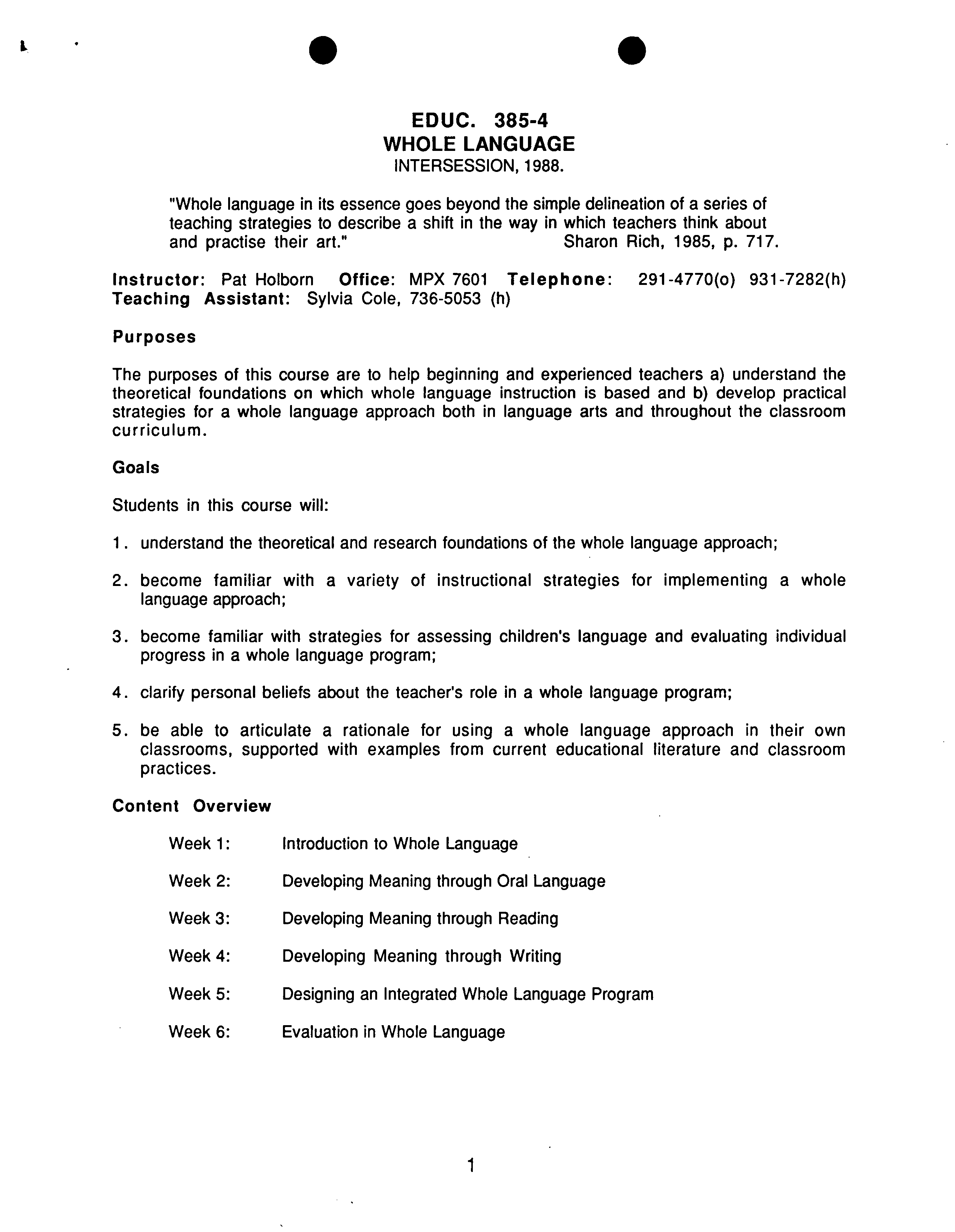I
?
S ?
.
EDUC. 385-4
WHOLE LANGUAGE ?
INTERSESSION, 1988.
"Whole language in its essence goes beyond the simple delineation of a series of
teaching strategies to describe a shift in the way in which teachers think about
and practise their art."
?
Sharon Rich, 1985,
p.
717.
Instructor:
Pat Holborn
Office:
MPX 7601
Telephone: ?
291-4770(o) 931-7282(h)
Teaching Assistant:
Sylvia Cole, 736-5053 (h)
Purposes
The purposes of this course are to help beginning and experienced teachers a) understand the
theoretical foundations on which whole language instruction is based and b) develop practical
strategies for a whole language approach both in language arts and throughout the classroom
curriculum.
Goals
Students in this course will:
1.
understand the theoretical and research foundations of the whole language approach;
2.
become familiar with a variety of instructional strategies for implementing a whole
language approach;
3.
become familiar with strategies for assessing children's language and evaluating individual
progress in a whole language program;
4. clarify personal beliefs about the teacher's role in a whole language program;
5. be able to articulate a rationale for using a whole language approach in their own
classrooms, supported with examples from current educational literature and classroom
practices.
Content Overview
Week 1:
?
Introduction to Whole Language
Week 2: ?
Developing Meaning through Oral Language
Week 3: ?
Developing Meaning through Reading
Week 4:
?
Developing Meaning through Writing
Week 5:
?
Designing an Integrated Whole Language Program
Week 6: ?
Evaluation in Whole Language
1
S ?
•
Format
The course addresses both theories of whole language development and instruction and the
more practical, day-to-day aspects of teaching using a whole language approach. Therefore
classes will include a variety of learning opportunities such as lectures, class discussions,
small-group tasks, experiential learning activities and student presentations.
During the course students will be asked to participate in activities which model whole
language teaching strategies. Participants are encouraged to study these experiences from the
viewpoint of learners as well as teachers.
Readings
Required
Hansen, J., Graves, D., & Newkirk, T.
Breaking Ground: Teachers Relate Reading and
Writing in the Elementary School.
ISBN 435-08219-1
Newman, Judith (ed).
Whole Language Theory In Use.
ISBN 435-08224-2
Recommended
Booth, D., Swartz, L., & Zola, M.
Choosing Children's Books.
ISBN 0-921217-12-9.
Calkins, L. McCormick.
The Art of Teaching Writing.
ISBN 435-08246-9.
Waterland, L. (1985).
Read With Me: An Apprenticeship Approach to Reading.
Thimble Press. ISBN 0-903355-17-5
Throughout the course the instructor will suggest additional articles and books for
enrichment reading pertinent to topics discussed in class.
Assignments
1.
Maintain a double-entry journal as a tool for making meaning of your learning
experiences during the whole language course. Complete brief journal writing activities
assigned by the instructor. At the end of the course submit to the instructor a journal
summary which documents your overall professional growth and insights during the
course.
Due Session 12 ?
20%
2.
Read several children's novels or picture books. Following the guidelines provided by the
instructor, choose one or more that you like and prepare a short
(no more than 8
minutes)
book talk to present in class.
Due Session 5 ?
15%
3.
Choose at least one professional book (other than the required readings) or a selection of
4-5 journal articles to enrich your understanding of language development, whole
language theory or a related topic. Use the double-entry journal described in class to
record and analyze your responses to the reading. Prepare a brief written analysis of the
book which summarizes its content and evaluates its usefulness to teachers of whole
language. Be prepared to discuss your reading in class.
Due Session 9
?
15%
2
. ?
.
4a.
Examine and critique a commonly-used basal reader, addressing its strengths and
weaknesses. Describe how you might use one unit from the reader as part of a whole
language program, explaining what you would teach and how you would extend the stories
in the unit.
Foil
4b.
Develop, implement and evaluate a writing project in your classroom using pre-writing,
writing and post-writing activities and conferencing procedures. Prepare a written
summary describing and evaluating your project.
Eel
4c.
Develop a presentation for parents, administrators and/or colleagues which explains the
rationale for a whole language approach, illustrates some of the teaching strategies you
might use in your classroom program, and describes some methods you might use to
evaluate pupil progress.
Due Session 11 ?
40%
PLEASE NOTE: ASSIGNMENT 4 MAY BE DONE AS A GROUP ASSIGNMENT
Evaluation
Assignments will count 90% toward the course grade. The remaining 10% will be based
on participation. Participation will be assessed on the basis of the individual's involvement in
class activities, contributions to discussion, and sharing of ideas and materials. Thoughtfulness
as well as frequency of contributions will be considered.
Students will be expected to participate in a final evaluation conference with the
instructor or teaching assistant during the last week of classes or the immediately following
week.
Grading Criteria
A ?
Represents superior (A-) to exceptional (A+) performance which goes beyond the
specified requirements of the assignment(s).
B ?
Represents good (B-) to very good (B+) performance which meets all the specified
requirements of the assignment(s).
C ?
Represents acceptable (C-) to satisfactory (C+) performance.
D Represents clear deviation from acceptable standards, including: Major factual
inaccuracies, major gaps in the knolwedge base, ambiguous, unclear or inaccurate
presentation, poor organization leading to lack of coherence, and major errors in style.
E ?
Represents serious deviation from acceptable standards, including all the deficiencies of
a D plus a major misunderstanding of the focus of the assignment.
F ?
Represents a lack of content in major areas of the assignment.
3



